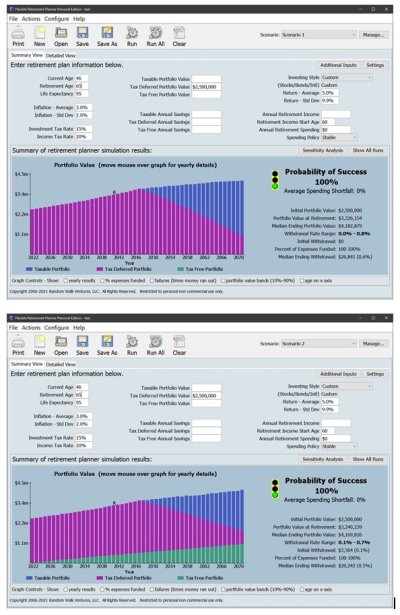Rainbowdash
Recycles dryer sheets
- Joined
- Mar 11, 2015
- Messages
- 66
Hi, this is a question to all of you experts in the forum. We are a family of 3, 46,45,13. We are retired for about 2 1/2 years already. MFJ taking standard deduction. Our dividends from taxable accounts in 2021 was about $160k, this comes from mostly low fee index funds and covers our yearly expenses without selling shares. However I have a $2.5 M 401k that is pretax. I would like to do some Roth conversion, but how much?
If I don’t do any conversion, I pay very little in taxes. First $115k of dividends is 0% (including HSA and carry over capital loss) next $45k is 15% or $6750 (effective tax rate of 4.2% from my total dividend income) The fact that dividends stack on top of roth conversions, it will make my conversion tax bracket look like this:
1. First $35k will be 15%
2. Next $20k will be 25%
3. Next $35k will be 27%
4. Next $25k will be 30.8% (NIIT added)
5. Next $45k will be 40.8%
6. Next $45k will be 25.8% (yes it goes down)
7. Next $45k will be 27.8%
8. Next $115k will be 24% (yes it goes down again)
Is my math right?
Confession, I always planned to convert to the top of 12% income bracket, little do I know, it starts at 15%. If I convert to the top of 12% income bracket ($115000), I will be paying an extra $27500, for an effective tax rate of 24%
Our goal is not to convert it all as we want to take advantage of QCD at 70 years old and donate the max amount every year to charity. Neither my wife or I have longevity in our family. Any comments are more than welcome
Thank you
If I don’t do any conversion, I pay very little in taxes. First $115k of dividends is 0% (including HSA and carry over capital loss) next $45k is 15% or $6750 (effective tax rate of 4.2% from my total dividend income) The fact that dividends stack on top of roth conversions, it will make my conversion tax bracket look like this:
1. First $35k will be 15%
2. Next $20k will be 25%
3. Next $35k will be 27%
4. Next $25k will be 30.8% (NIIT added)
5. Next $45k will be 40.8%
6. Next $45k will be 25.8% (yes it goes down)
7. Next $45k will be 27.8%
8. Next $115k will be 24% (yes it goes down again)
Is my math right?
Confession, I always planned to convert to the top of 12% income bracket, little do I know, it starts at 15%. If I convert to the top of 12% income bracket ($115000), I will be paying an extra $27500, for an effective tax rate of 24%
Our goal is not to convert it all as we want to take advantage of QCD at 70 years old and donate the max amount every year to charity. Neither my wife or I have longevity in our family. Any comments are more than welcome
Thank you

